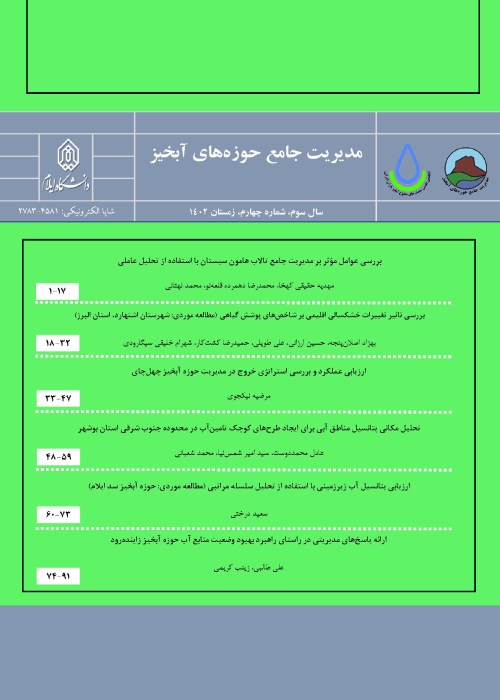Spatial analysis of water areas potential for small water supply projects in the southeast of Bushehr province
Locating and building small water projects in hot and dry areas of the country that are facing water shortage is of great importance. These projects are more popular among farmers than other water supply and storage projects due to simple construction technology, low study and implementation costs, public participation, simple operation and maintenance, and environmental effects. The use of new sciences, especially Remote Sensing techniques (RS) and Geographic Information System (GIS) helps planners to locate water supply and storage projects. Various studies have been conducted in the world in relation to location, analysis of factors affecting the location of water storage and supply plans using different criteria and using RS and GIS techniques. The aim of the present study is to identify and introduce water areas with the potential to create small water supply projects in the southeast of Bushehr province.
This research was conducted in Dayyer City in the southeast of Bushehr Province with an area of 2306 Km2 and a mean rainfall of 215 mm. In order to achieve the goal, first, nine flood-producing criteria including the slope, aspect of slope, river density, height, rainfall, runoff, distance from the river, land use and geological formations were considered. Then, using AHP method and weighting and prioritization of effective parameters and taking into account other environmental conditions and the overlap of maps, the final flood map of the city was prepared and classified. After calculating and estimating the degrees of importance, ArcGIS was used as a decision support system for future calculations. Also, Google earth and Arc Scene software have been used for better analysis and better understanding of the results in preparing the 3D space of the study area. After preparing the maps of the distribution and location of the wells and waterways network, the opinions of the relevant experts were also used. Also, other factors such as downstream land use, topography and access roads, drinking water consumption, livestock drinking consumption, the widest points in terms of the storage resource level and the ease of implementation of the structure were also considered as quality and management criteria.
The results showed that the region can be divided into five regions with very low, low, medium, high and very high in terms of flood vulnerability risk. Also, the results of flood zoning showed that the extension of the northern and northeastern elevations to the east of Dayyer City and the middle elevations of the city and its center have high flood potential. According to the area of the study area, 25.2% are in the high vulnerability class and 11.5% in the very high vulnerability class. In addition, the results showed that 25 places in the region are suitable for creating small water supply projects, which, if implemented, can be effective in collecting and supplying water and increasing the profitability of the region in addition to controlling seasonal floods.
Based on the results of this research, it is concluded that more than one third of the region (36.7%) has a high to very high risk of flooding, so these areas should be the focus of urban management planning. Also, 25 places in the region were suitable for creating small water supply projects, which need to be considered by regional managers and planners to reduce the effects of water shortage of the region. In addition, this research showed the good performance of GIS and AHP method in flood risk zoning and locating of small water supply projects in Dayyer City. Another noticeable point is that there are about 4217 hectares of land under dry wheat cultivation in the 23 proposed points of downstream, and currently the harvest of rainfed wheat is 1.3 tons per hectare on average. If appropriate water supply plans are implemented, the total harvest amount can reach about 16,000 tons per year. Therefore, making suitable water supply plans can result in an increase in production.
- حق عضویت دریافتی صرف حمایت از نشریات عضو و نگهداری، تکمیل و توسعه مگیران میشود.
- پرداخت حق اشتراک و دانلود مقالات اجازه بازنشر آن در سایر رسانههای چاپی و دیجیتال را به کاربر نمیدهد.



